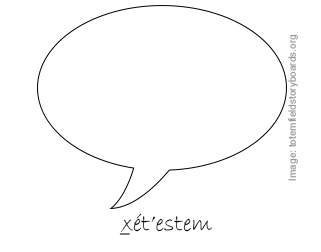X̲ét’estem means ‘…is said (to be)‘.
Vocabulary and Pronunciation
- X̲ét’estem sounds like HUTT-uh-stumm, except that instead of an h you say the Halq’eméylem hard-x, and the t is ‘popped’
- To make the hard-x (x̲), you create friction with the back of your tongue touching against your uvula (see here for more information on this sound).
- To make the popped-t (t’), you combine a regular t with a catch in the throat (glottal stop).
Audio: Elizabeth Herrling
Structure notes
X̲ét’estem is based on x̲ét’stexw – to tell. The Elders make the word by adding the ending -em, called the ‘passive’ endin, like this:
The -em ending makes the ‘passive’ form, which changes the meaning from ‘tell’ to ‘is told (to be)‘ or ‘is said (to be)‘.
As illustrated above, the -exw part of the base word disappears when you add the -em.



No comments yet.